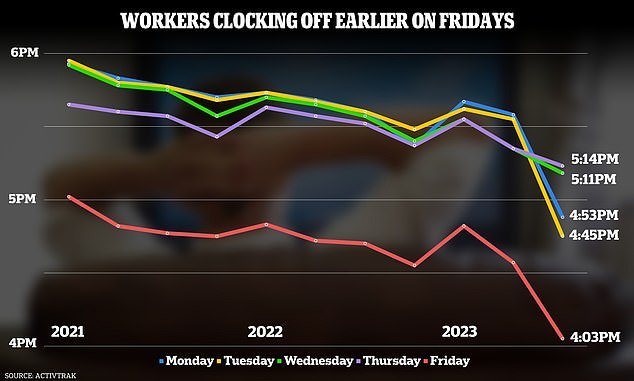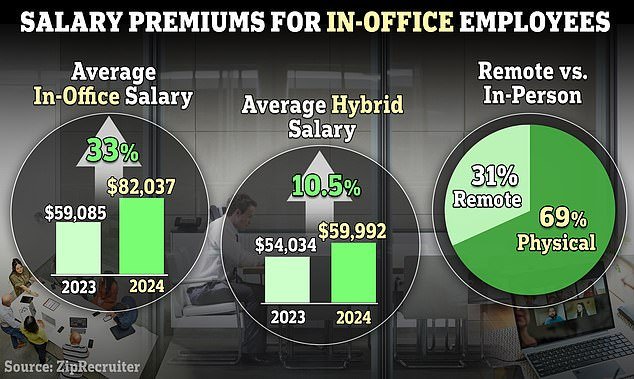American workers now leave work an hour earlier on Fridays than in 2021, new data revealed.
The average employee now says goodbye at 4:03 p.m. on the last day of the work week, according to an analysis of 75,000 workers by analytics firm ActivTrak.
This compares to 5:01 p.m. in 2021, when many people were working from home during the pandemic lockdowns, making it easier for work to blend into the evenings.
Employees also finish work earlier during the rest of the week, the research revealed.
While in 2021, the average worker finished work after 5:30 pm Monday to Thursday, they now finish at 4:45 pm in the early stages of the week.

American workers now leave work an hour earlier on Fridays than in 2021, new data reveals.
In the third quarter of 2023, Americans typically left at 5:14 p.m. on Thursdays and 5:11 p.m. on Wednesdays, research from the workforce analytics firm revealed.
On Mondays, Americans typically left the office or turned off their laptops at 4:53 p.m. But the earliest time was on a Tuesday, when the average worker quit at 4:45 p.m.
It comes amid an ongoing debate between employers and workers about the benefits and drawbacks of working from home or hybrid work schedules.
During the Covid-19 pandemic, millions of Americans were forced to leave the office due to stay-at-home orders, changing the configuration of their offices overnight.
In the years since, some companies have ordered workers to return to the office, while others have allowed employees to continue working from home or allowed flexible work schedules.
Wall Street stalwart Jamie Dimon has been one of the phenomenon’s biggest critics.
Last year he said The Economist He didn’t see how managers could work from home and added: “I don’t know how you can be a leader and not be completely accessible to your people.”


Employees also finish work earlier during the rest of the week, the research revealed.
Some companies have largely given up Fridays to work from home, meaning many Americans view the last day of the work week as a slow transition to the weekend.
ClassPass, a subscription app that allows members to access thousands of gyms, salons and spas, found that Fridays were the most popular day of the week in 2023 for scheduling wellness and beauty services. The Wall Street Journal reported.
Location technology company TomTom found that Friday afternoon is one of the busiest times on roads in major cities, the outlet reported, as people leave early for weekend trips.
It comes as separate research suggested that Americans prepared to work in an office rather than from home or in a hybrid role will earn more money.


US companies are paying a premium for employees who will work in the office full time, new data shows
The average advertised salary for office workers has increased 33 percent to $82,037 compared to a year ago, according to ZipRecruiter research.
By comparison, the average salary for a “hybrid” employee is just $59,992, a difference of $22,000.
Experts say those companies that want on-site staff have to pay them more, to compensate for giving up the convenience of working from home, as well as covering overtime and the cost of travel.
Julia Pollak, chief economist at ZipRecruiter, told the BBC: “Employers who cannot compete on flexibility will have to compete more aggressively on pay.”
Interestingly, the data shows that hybrid workers were penalized more than fully remote employees who can expect to earn $75,327 a year on average.
